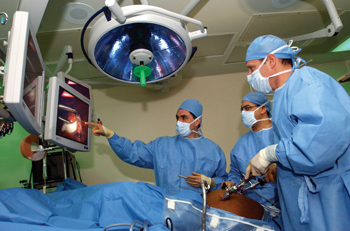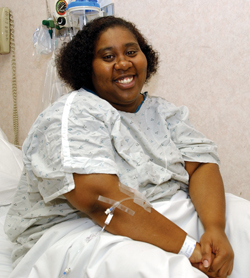
Proctor Jamime Ponce, M.D., left, Willie Melvin, M.D., center, and Michael Holzman, M.D., perform the new gastric banding surgery for weight loss.
photo by Anne Rayner
Procedure helps expand weight loss surgery options

Connita Ransom was one of the first patients to undergo the new gastric banding surgery for weight loss.
photo by Anne Rayner
Vanderbilt University Medical Center is now offering Lap-Band adjustable gastric banding as a surgical weight loss option. Under the guidance of a proctor, Michael D. Holzman, M.D., associate professor of Surgery, and Willie Melvin, M.D., assistant professor of Surgery, performed the first three procedures using the banding method on Friday, Feb. 18.
“Offering Lap-Band gives us the opportunity to provide more patients with the option of weight loss surgery, such as those who might not be candidates for gastric bypass or simply may not want to undergo that particular procedure,” said William Richards, M.D., professor of Surgery, director of Laparoendoscopic Surgery and medical director of the Bariatric Surgery Center.
During the one-hour laparoscopic operation, an inflatable silicone band is implanted around the stomach, creating a small pouch and a small outlet into the rest of the stomach and intestines. The band induces weight loss by reducing the capacity of the stomach, thereby restricting the amount of food that can be consumed.
Unlike gastric bypass surgery, the Lap-Band procedure does not involve any cutting, stapling or re-routing of the stomach or intestines, and because food continues to pass through the rest of the stomach and the full intestinal track, there is no mal-absorption.
“The Lap-Band procedure may be an option for those who couldn't undergo gastric bypass because of anemia or medication requirements for non-weight related conditions — those who could not tolerate mal-absorption,” Richards said.
The silicone band is also adjustable, allowing physicians to increase or decrease the size of the stomach based on the patient's needs. A tube runs of out the Lap-Band and is connected to a reservoir, which can be entered with a fine needle through the skin to increase or decrease the amount of saline in the band. The more saline injected into the Lap-Band, the more constricted the patient's stomach will be.
“This procedure would be a better option [than gastric bypass] for a young female who may be interested in getting pregnant,” said Holzman. “The band could be adjusted to accommodate the dietary needs of pregnancy. It could also be adjusted if someone is ill, or is simply losing weight too quickly or too slowly.”
While the procedure offers more flexibility than the gastric bypass method, it also produces slower results. Gastric bypass patients will lose the majority of their weight in 18 months, whereas it may take Lap-Band patients approximately four years to lose the weight.
“With this method, you still have to work hard to lose the weight. The small stomach holds less food and will help the patient feel full, but the patient must be committed to eating a good diet and exercising,” Holzman said. “Patients must also undergo regular follow-up visits for the best results.”
For Connita Ransom, 31, a nurse and mother of two, the Lap-Band procedure seemed like the best option to help her lose weight. At 5-foot-5-inches and 310 pounds, Ransom was one of Vanderbilt's first Lap-Band patients last week.
“I wanted a less-invasive and less extreme procedure,” Ransom said. “I have two kids to take care of and can't afford to be sick and feeling bad. And I don't mind if it takes me longer to lose the weight — I'm not looking for a quick fix. I figure it took me 12-13 years to gain the weight, I can take some time in losing it. I want to feel healthy as I'm losing the weight.”
Ransom said her family history of diabetes and heart disease prompted her to take action. Not only does she want to take control of her health, she said she wants to be a good example for her children.
“I want to be able to be active and to keep them active so they don't have to struggle with their weight,” Ransom said. “I'm already looking forward to going to the YMCA with them.”
Ransom said she's also looking forward to doing water aerobics, and eventually kickboxing. And yes, she's purchased a little black dress.
“I'm in no hurry to fit into it, but it's a good reminder of what I'm working towards,” she said.
After her surgery, Ransom said she was feeling some pain from the procedure, but had a noticeable decrease in her appetite and was doing well.
As with gastric bypass surgery, the Lap-Band procedure patients must meet the National Institutes of Health's criteria.
Potential surgical candidates need to be 100 percent above desirable weight; have a body mass index (BMI = weight in kilograms divided by height in meters squared) of greater than or equal to 40 with no existing comorbidities or have a BMI of greater than or equal to 35 with coexisting medical complications; have failed at non-surgical methods of weight reduction; have an absence of endocrine disorders that can cause massive obesity; and be psychologically stable.













